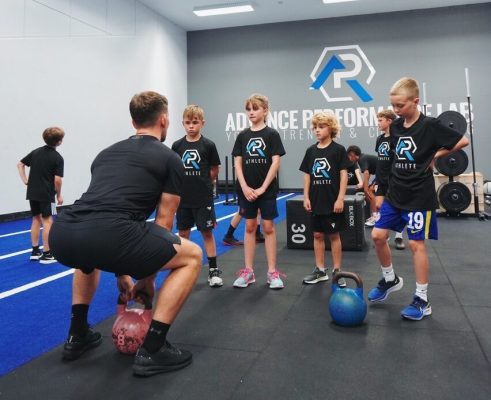We often post our athletes training at our Performance Lab to raise awareness, education and the importance of youth strength and conditioning. Encouragingly most of the messages and feedback we receive are supportive, which feels great, as I remember a time where strength training and plyometrics were questioned for young athletes. However, at times, some of these messages can be extremely negative. I’ll give you some examples… “that doesn’t look right, that kid’s knees shouldn’t be falling in/out, their feet are coming off the floor or their knees shouldn’t go past their toes”, “you guys should be coaching them or correcting their movement”.
As a strength coach and someone who spends time reading through the journals and research, I absolutely welcome feedback, questions, and collaboration, as the strength and conditioning community should work together, especially with the development of young athletes.
With this in mind, I felt it necessary to reach out to our audience to give some context on why we do what we do at our Performance Lab and with our network of athletes. Living in a digital world is great as we can communicate with a wide range of individuals, but we must be careful about being first or posting something new just for the sake of clicks and likes. As strength coaches working with youth athletes, we have a duty and responsibility, in conjunction with a long-term athlete programme and an athlete-centred approach, to always put the athlete first.
You may or not be aware that each exercise comes with its own technical model, which is based upon some research, some opinions, and a bucket load of ‘this is how I perform the exercise”. Whilst a technical model may be the end goal or set some rough guidelines on how the exercise should look, we must appreciate that each athlete is unique and therefore, will not be able to perform the exercise to the letter initially or maybe not at all. This is because every athlete has their own individual characteristics i.e., limb length, torso length, experience, strength levels, maturation, confidence… the list is probably endless!
Therefore, as a team our philosophy is, view the athlete as an individual and to understand that the athlete is in a process of learning. If we create an environment and set up the exercise allowing the athlete to learn, at this stage the technical model is redundant. We are going through motor skill learning, which if the model is correct, whatever correct is, has a cognitive stage, associative stage, and autonomous stage.
We do not want to remove the learning, especially the cognitive stage, where the athlete is working through a host of new information and stimuli. As the athlete performs numerous repetitions of the movement, errors will be made and viewed, we can place this under the umbrella term experience and training age. Through the athlete’s learning journey of experiencing the exercise, the movement, the errors and perhaps through feedback mechanisms, they finally understand how it feels, and self-organised their technical model.
To continually try to force an athlete into a movement strategy that is based on the technical model, as previously mentioned, this may rob that athlete of learning, simply to make the coach, especially on social media, look good or to validate what they feel the exercise should appear. I also get nervous when strength programmes are sold as shortcuts or get stronger and faster in 2 weeks – please remember, if working with young athletes, it’s a Long-term Athlete Development programme. Coaches, and this may come from coaching courses and passing certificates, give an endless number of cues, generally talking about joint angles or muscle movements, using language that is alien to the athlete, making them think more about parts of the exercise than the outcome of completing the task.
An example of learning through a change in environment might be decreasing the range of movement that the athlete works through i.e., placing a bar on plates or blocks whilst deadlifting or, another example, when an athlete initiates a squat, knee firsts and is very ‘toey’, having the athlete sit on to a box. The athlete will then perform the task with some degree of success, which will further drive motor learning and feedback relative to the specific task.
I am not saying that athletes should not know what muscles are working and what adaptations the coach is looking for, but only if they enquire and not while they are trying to work things out. From my experience, most athletes want to know how to execute the movement and whether they are getting better at it, this ‘better’ or improvement simply comes from practice, practice, practice. They do not need to know the kinematics of the movement.
Finally, and just a closing remark, we did not learn to walk from a technical model, we all learn in our own time through trial and error. Arthur, my 9-month-old is learning to walk, through a combination of little success of reaching a toy or the sofa, and a load of falling over (errors!). All I can do, as a parent, is to facilitate that learning. Make sure that the environment is safe, the environment is set up in a way that he understands the task and empower him to try. And, probably the most important factor is to encourage when he makes errors to try again. Over time, and making lots of errors, Arthur has learnt to self-organise, moving from a cognitive stage to an autonomous stage. For example, he will set his feet wider apart when trying to stand up, to ensure that he can maintain his centre of mass and balance. His coordination will be improved and again through feedback mechanisms, he will be able to read the environment and adjust his posture to minimise errors. He is probably 2-3 months away from walking, the autonomous stage. Decision time, should I look to accelerate his development by teaching him from a technical model, via activating muscles in a set order, setting his core, and dictating his movement sequence, or should I allow him to work it out like humans have done for millions of years?!
Robbie Trimm
MSc Strength and Conditioning





